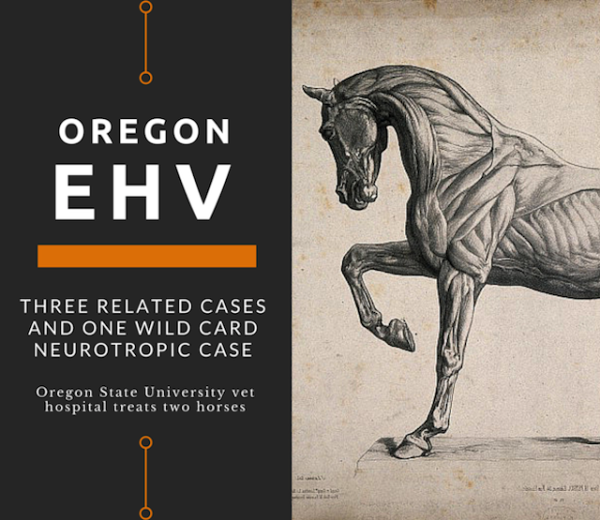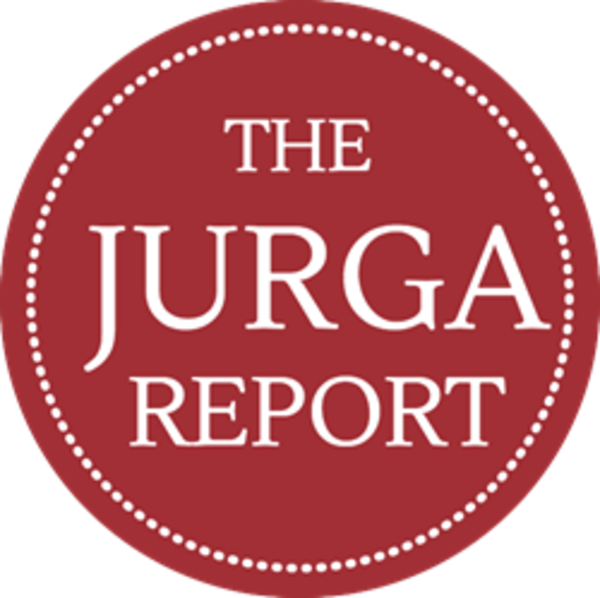Equine Herpes Virus Intensifies and Diversifies in Oregon Horses
- March 10, 2017
- ⎯ Fran Jurga
Infectious disease outbreaks should be pretty predictable, once they get rolling. But sometimes, they aren’t. There can be a wild card in the deck. A case shows up to intensify the situation. Officials scratch their heads and wonder how or if the horses ever crossed paths, but the wild card might even show signs of suffering from a different form of the disease.

That appears to be the case in Oregon this week, where a lone horse has shown up with the neurotropic form for the equine herpes horse, and three horses have shown up with the more common respiratory form of the virus. The three have either been in the same shows or home stables or crossed paths somehow, but the fourth is sick with a more serious form of the virus.

The neurotropic case ane one of the “typical” EHV cases have been admitted to the Lois Bates Acheson Veterinary Teaching Hospital at Oregon State University College of Veterinary Medicine in Corvallis. The university shared a bulletin with us on Tuesday night about the cases in Oregon.
According to the university statement, the initial case of EHV-1 is being treated in isolation at OSU, and only had the more common “wild” strain of the virus. That horse did show neurologic symptoms, although animals with that strain of EHV-1 more often have a disease that causes respiratory infection or abortion in pregnant mares.
That initial case is normally housed in Marion County and had recently attended events at the Linn County Fairgrounds in Albany on April 16-19. Before that horse developed clinical signs and institution of the quarantine, horses housed with the initial case had attended an event at the Oregon Horse Center in Eugene on April 25-26.
Two more cases have been identified of horses with the wild strain. These horses are not showing signs of neurologic disease, and they are being treated at their home stables in Polk County. Both forms of EHV-1 are highly contagious to horses, but not transmissible to people.
However, a fourth case has been confirmed with the neurotropic form of EHV-1, veterinary experts say, which increases the seriousness of the current outbreak, and makes it increasingly important that horse owners in Oregon practice strong biosecurity management of their animals.
“About 80 percent of the horses who develop neurologic problems from EHV-1 have the neurotropic form of the virus,” said John Schlipf, DVM, MS, DACVIM, a large animal internal medicine specialist with the OSU College of Veterinary Medicine. “It’s a significantly more serious concern. The disease can be fatal, or it can cause lasting neurologic damage that leaves the animal with a permanently reduced level of function.”
The most recent (fourth) case was brought to OSU’s Lois Bates Acheson Veterinary Teaching Hospital from the Salem area. Both cases are being treated in isolation, and all OSU veterinary teaching hospital facilities are open for business as usual.
The newest case was not at the Linn County event, Schlipf said, but had been in contact with other horses that attended.
Since there’s a 10 to 14 day incubation period for this virus, Schlipf said, it is possible that more horses will be found to be infected. Owners of horses that may be at risk are encouraged to monitor their animals closely for a fever and any signs of respiratory or neurologic disease.
More information about the virus and biosecurity recommendations is available online from the American Association of Equine Practitioners.
Early clinical signs of the neurologic form of EHV-1 often begin with the hind limbs and include:
- Uncoordinated, stumbling movements;
- An unusual gait;
- A weak tail tone;
- Difficulty urinating, and dribbling of urine;
- Nasal discharge, frequently accompanied by a fever.
The Oregon Department of Agriculture recommends that horses that attended the Albany or Eugene events avoid contact with other horses and have their temperatures monitored twice daily. Temperatures over 101.5 degrees may indicate illness.
Horses with these signs should be isolated from other animals, and owners should contact their veterinarians immediately. EHV-1 can also affect alpacas and llamas, Schlipf said.
“We must reiterate the need for horse owners to practice biosecurity,” Schlipf said.
“People handling horses should wash their hands and clothing to reduce spread of a virus,” he continued. “Animals should not share tack, and horses that have traveled or mingled with other animals should be segregated.
“All of these steps can help, and are especially important right now. It may be a while yet before we are out of the woods with this outbreak,” he said.
The Oregon State bulletin fleshes out a briefer document provided by the Oregon Department of Agriculture earlier. The ODA mentions four farms under quarantine: one in Marion, one in Polk and two in Linn counties.
ODA is working to notify owners of horses that have been potentially exposed and has notified Oregon equine veterinarians.








